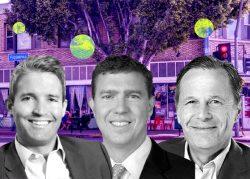A Beverly Hills developer has beat back community appeals on plans to build 100 apartments in Highland Park.
Michael Naim, architect and developer of Naim Associates, got an OK from the Los Angeles City Planning Commission, which voted down two appeals challenging the seven-story complex at 3836 North Figueroa Street, Urbanize Los Angeles reported.
The complex, dubbed Belvedere, would include one-, two-, three-, four-, and five-bedroom apartments above 14,700 square feet of ground-floor shops and restaurants. A semi-underground garage would serve 114 cars.
The controversial project, in the pipeline since 2018, secured a letter of determination from the Planning Department last September.
It uses Transit Oriented Communities incentives to permit a larger building than allowed by zoning rules in exchange for 10 affordable apartments for extremely low-income tenants.
Naim’s design for the Mediterranean-style complex includes a white stucco exterior and multiple roof terraces, inset balconies and light brown awnings.
The apartment complex would be joined by a 4,800-square-foot public plaza at North Figueroa and Pasadena streets, and include a podium-top courtyard and pool deck.
Construction is expected to take two years, with an undisclosed timeline.
The planning commission considered two appeals of project entitlements, submitted by Saul Ramirez, a neighboring resident, and Derek Ryder who is identified as a member of the Arroyo Seco Alliance. Both argued the project was inconsistent with zoning regulations and planning goals, and should be subject to further environmental review.
Their concerns were echoed by dozens of local residents, who urged that the project be scaled back in size or be required to offer more affordable units. Others said the project would accelerate gentrification, and alleged racism on the part of the project’s developer.
Naim, in comments before the Commission, spoke to the costs incurred in fees for the project, as well as his surprise at the chilly reception from residents of Highland Park, according to Urbanize.
He said he’s made numerous revisions to the development in the past five years to better match the “design narrative” of the neighborhood.
Helen Campbell, a former Planning Commissioner and current Planning Deputy for City Councilmember Eunisses Hernandez, thanked both Naim and the appellants for attempting to iron out their disagreements in a recent in-person meeting.
She said the city had limited discretion to force changes to the project because of its status as a TOC development, plus a state law that limits the maximum number of public meetings certain housing developments may be subjected to.
She did offer potential compromises for which Naim could volunteer, including the inclusion of affordable commercial units at street level, as well as a larger setback next to the home owned by Ramirez.
Naim, in response, agreed to offer two ground-floor commercial stalls at 50 percent of the prevailing rent for the other retail tenant spaces.
While he denied the setback request, he indicated the project would incorporate step backs on the upper floors to reduce the building’s scale. He also agreed to a right-of-return provision for existing tenants on the property, if they meet income eligibility requirements.
— Dana Bartholomew
Read more



